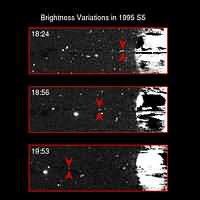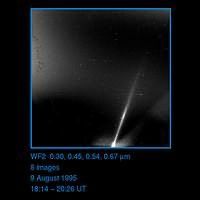1 min read
Motion of Saturn’s Satellites

This sequence of 100 sec exposures taken with HST's Wide Field and Planetary Camera (WFPC2) in planetary mode on 10 August 1995 shows three of the smaller satellites of Saturn, as well as the newly discovered object 1995S5. Epimetheus is the smaller co-orbital satellite and about 120 km in diameter, while 88 km diameter Pandora is the outer shepherd satellite of the narrow F Ring. 1995S5 appears as a faint smudge in the plane of the rings. The outward orbital motions of Pandora and 1995S5 are apparent, as are the displacements of Epimetheus and Mimas to the north and south of the ring plane, due to the slight inclinations of their orbits relative to Saturn's equator. The brightness of 1995S5 is consistent with an object of diameter 50 km or less.
These images were obtained approximately one hour before the Earth crossed Saturn's ring plane and an 8922 A methane band filter was used to reduce the scattered light from the planet. An average of several earlier frames was subtracted from each image to remove the edge-on rings, and so reveal the fainter satellites. Some residual artifacts of this subtraction process are visible. Structure on the planet is due to cloud features which changed position as the planet rotated. Unlabelled bright spots and streaks are due to cosmic ray hits on the detector.
- Object NameObject NameA name or catalog number that astronomers use to identify an astronomical object.Saturn, Epimetheus, Pandora, Mimas
- Release DateAugust 11, 1995
- Science ReleaseHubble Again Views Saturn’s Rings Edge-On
- Credit
Related Images & Videos

Saturn's Rings Edge-on
Saturn's magnificent ring system is seen tilted edge-on - for the second time this year - in this NASA Hubble Space Telescope picture taken on August 10, 1995, when the planet was 895 million miles (1,440 million kilometers) away. Hubble snapped the image as Earth sped back...

Reappearance of Saturn's Satellite Mimas
On 10 August 1995 HST observed the second passage of the Earth through Saturn's ring plane in the 1995/96 series of triple crossings. This pair of 100 sec exposures was taken with the Wide Field and Planetary Camera (WFPC2) in planetary (high resolution) mode 2.5 hours prior to...

Brightness Variations in Saturn's Satellite 1995S5
This sequence of 100 sec exposures taken with HST's Wide Field and Planetary Camera (WFPC2) in planetary mode on 10 August 1995 shows the newly discovered object 1995S5 (red arrows) moving in its orbit around the planet. As it moves further from Saturn, its brightness decreases...

Saturn's E Ring in Ultraviolet Light
Visible from Earth only at times of ring plane crossing, Saturn's tenuous E Ring was discovered during the 1966 crossings and imaged again in 1980. From these observations, its color is known to be distinctively blue. The E Ring was captured in ultraviolet light for the first...
Share
Details
Claire Andreoli
NASA’s Goddard Space Flight Center
Greenbelt, Maryland
claire.andreoli@nasa.gov




























